Have you ever considered the environmental impact of dog ownership?
Read on to find out more from Buriton Environmental Association, and pick up some tips on how to 'green your dog'!
There are over 13 million dogs in the UK, living in 36% of our population’s households. They give us a lot of happiness and we give them a lot of ‘things’, many of which are made of plastic or come in plastic packaging. Your pet relies on you to make all their choices for them - so any impact made on the environment through pet ownership is down to us humans. From feeding to entertaining them and cleaning up after them – your pet can end up fetching you mountains of unwanted plastic waste. Too much of this stuff doesn't get recycled and hangs around in the environment, posing a threat to wildlife.
We feed many of our pets meat-based products and processed foods, which are often transported from afar, increasing the pet’s carbon footprint without them knowing it. Fewer than 1 in 20,000 wet food pouches are recycled – making them more of a burden than single-use coffee cups!
In trying to keep our pets healthy, we apply pesticides to them which can wipe out millions of pollinators. Some of the tick and flea treatments contain insecticides banned in farming, but they still find their way into our pet products. We then release our lovely cats and hounds into the countryside armed with a fatal weapon to wipe out bees, bugs and vital aquatic life.
That’s the bad news, the good news is we can all do something about it and continue to love, spoil and enjoy our pets whilst being environmentally aware and responsible.
You might not have the time and resources to be super green but any little bit you can do will help. Many of you will already have some good ideas, but here are the ones that BEA (Buriton Environmental Association) recommends:
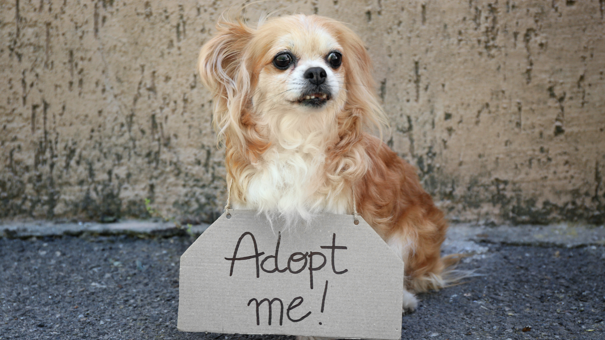
Adopt rather than buy
A dog which comes from a rescue centre is carefully chosen to fit in with a prospective new owner’s life and surroundings. Adopting means that you’re lowering demand for breeding new pets. Fewer pets mean using fewer resources like food, toys and shelter. And that means less plastic waste. You usually find that rescue centres offer lots of advice and support for pet owners which can really help your new family member settle in.
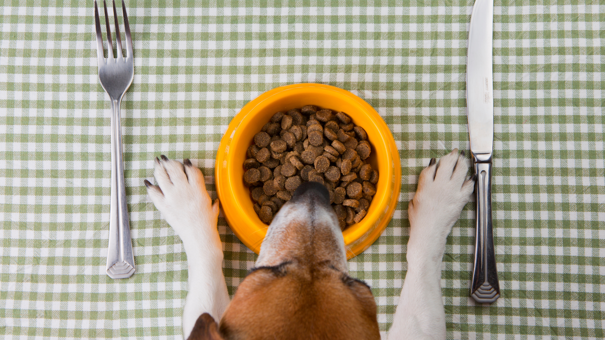
Avoid plastic food pouches and try a greener diet
Consider how your pet food is packaged. Buying paper-wrapped dried food in bulk helps to avoid plastic waste. Some brands use recyclable aluminium trays and tins instead of pouches for their wet food supplies.
Investigate alternatives to meat based products and try to shop local. Have a look at YORA insect based food – tried and tested by many a pet. The supply chain is never simple, but just a little bit of investigation might help you to source something very satisfying for your pet, made close by. Buying locally helps reduce the travel carbon footprint.
Very close to home is home, so what about making some of your own pet food – with guidance from the experts and, of course, avoiding anything that should not be in your pet’s diet. You could also reduce your own food waste by using leftovers which are healthy for your pet to consume too. Make a start by looking at the RSPCA website for a healthy dog treat you can bake at home. Always consult your vet before making any drastic dietary changes.
No need to rush out and buy new pet feeding bowls, charity shops often stock hand me down items, or you may well already have your own unused suitable bowl at the back of a cupboard. If you really are desperate to buy new then why not treat your pet to a bamboo or rice husk bowl.
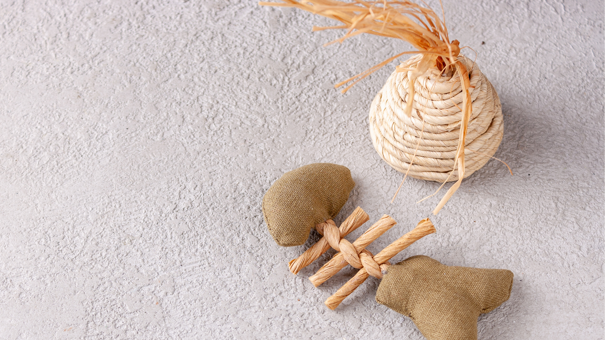
Buy eco-friendly pet toys
Some pets have more toys than children (and some of those toys may well have been stolen from children!). There are lots of things available for pets in charity shops. Some are especially made for dogs and just need a new home, others might be children’s toys, so check that they are safe for your pet with no dangerous stuffing or glass eyes.
If you are buying new, look out for toys made from hemp, bamboo and wood from sustainably managed forests. Hemp and bamboo are often labelled as environmentally friendly. In comparison, cotton toys require large amounts of water, pesticides and cheap labour to produce. You can find hemp dog bones, canvas squeaky toys and sisal-wrapped scratching, a natural plant fibre like hemp.
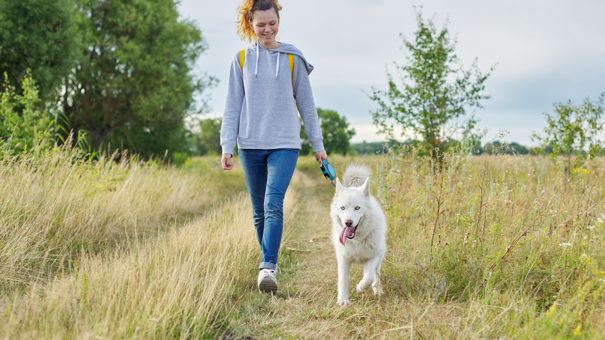
Don’t walk on the wildlife
Let your best friend lead you down the right path, literally, with an environmentally friendly hemp collar and dog lead. Hemp is strong, washable and antimicrobial. It's the eco warrior of the plant world - great for the soil, naturally resistant to most pests and less water-needy than other crops. Or again, try the charity shops. In particular, RSPCA and Dogs Trust usually have good quality second hand leads, collars and harnesses.
When out and about in the countryside abide by the ‘take the lead’ rule. Don’t let your pet upset the local wildlife. Particularly, where there are ground nesting birds, keep your pet on a short lead and closely supervised – or leave your pooch to snooze at home if you are visiting a sensitive site. When they are off the lead, in suitable areas, keep them under control. If you treat your pet with spray or spot on flea and tick applications, keep in mind that the active ingredient has a long-time residual which can last up to 90 days! Some of this can be particularly damaging to pollinators and the wildlife in ponds and rivers - read more here. There are natural, herbal alternatives as well as ingestible conventional treatments that are worth exploring.
If your pooch has had a wildlife friendly swim, or rolled in the mud (or something worse), they may well need a freshen up. Hosing down is usually sufficient but stubborn whiffs can be dealt with using organic pet shampoo. Or even better a plastic-free organic pet soap bar.
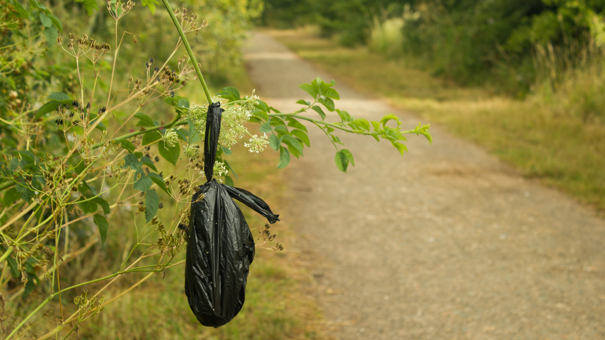
Pooping the green way
Compostable poo bags – good or bad? Let's clean up this mess right now! Brits are crazier about dogs than any other pet. There are over 13 million pet dogs in the UK and they produce 1,000 tonnes of poo a day. That means a mountain of plastic poo bags. So should you buy compostable ones? The easy answer seems to be yes, but…
If you dispose of them in the correct way (ie compost them), they're more environmentally friendly than standard plastic ones (the compostable bags are made from plant starch instead of climate-changing petroleum). But compostable bags need specific conditions, including oxygen and light, to break down. Unfortunately, the vast majority of compostable poo bags end up in landfill or the bottom of your compost heap, where there is no light and very little oxygen. Basically they'll become anaerobic, stink and stick around for absolutely ages.
There isn't a perfect solution right now. As well as smelling bad, dog faeces can contain nasty parasites and possibly insecticides from digested tick and flea treatment. This has led to warnings against either composting it or flushing it down the toilet, and of course it is illegal to leave dog poo in the environment.
In a Radio 4 Sliced Bread episode on the subject, experts concluded that unless you can collaborate with others to create a community composting solution (there are no composting facilities for dog poo in the UK), reusing plastic bags or choosing to buy bags with a high percentage of recycled plastic are the best options. The most important thing is that you pick the poo up and take it home or put it in an appropriate bin whilst out. That takes very little effort and has a massive positive impact on the immediate environment.
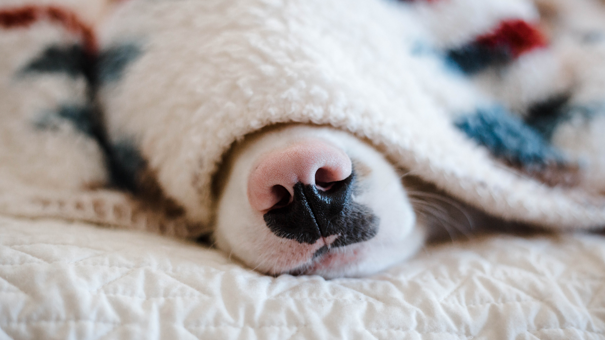
Let your pet sleep in a dreamy green environment
Recycling old plastic bottles into fleeces and pet supplies has got to be eco, right? Not so. People doing sciency things have discovered extremely small pieces of plastic in our oceans. Apparently, these bits have come from, you guessed it, products made from recycled plastic. Meaning this stuff is finding its way into the ocean anyway. Worse still, it draws in toxins like a sponge – which marine animals then ingest.
So why waste your money on those items, which are liable to come wrapped in plastic too? Why not be inventive and try something like an old suitcase and duvet topped with a second hand throw for your green dog’s bed? There will be plenty more creative ways to make sure that Fido or Felix gets a good night's sleep minus the plastic and manufacturing pollution. Create one yourself and send us a picture of your comfy green pup having a snooze.
If you’re short on materials to use, again, we have the jolly old charity shops to fall back on. Loads of lovely sheets, throws and blankets, available to pile on your old duvet or pillows. Your green dog will love to mess them all up and snuggle down knowing we are all being kind to the planet!
